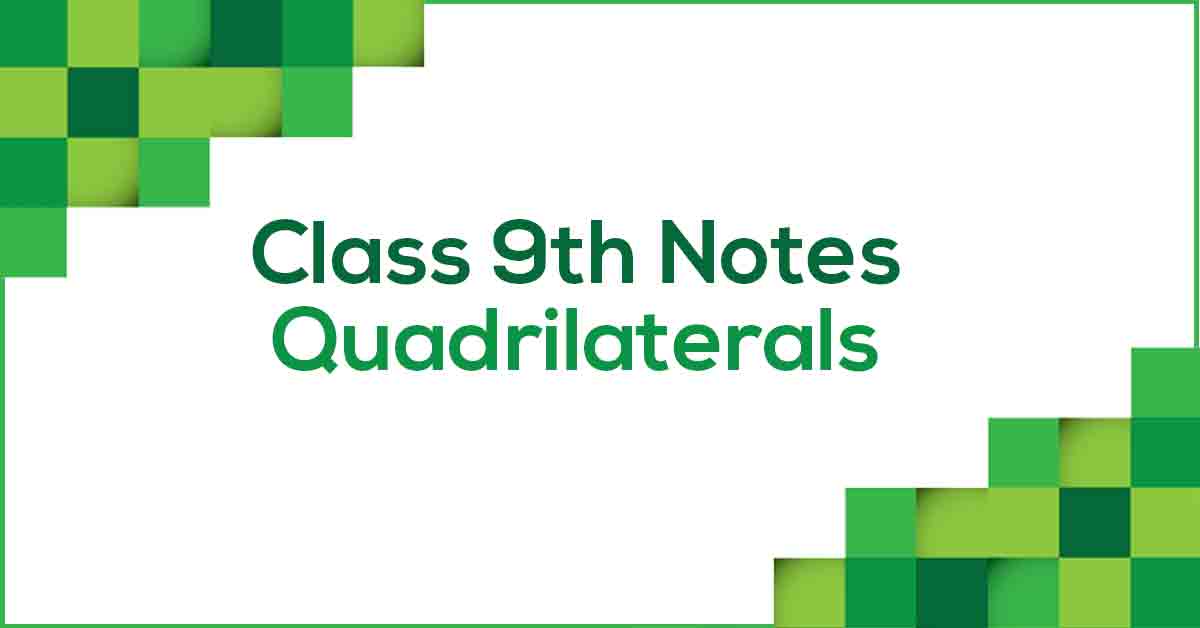Quadrilaterals Class 9 Notes

Chapter 8 Quadrilaterals
Chapter 8 Mathematics for Grade 9 covers the core concept of quadrilaterals. In this article, we have provided NCERT notes for chapters that entail solved text exercises. The notes were worked out in detail step by step by Vidyakul's academic experts. Students are encouraged to study notes carefully and practice diligently to prepare for the exam and achieve good grades.
These notes help students become familiar with the question format and improve their problem-solving skills. Students can visit Vidyakul to improve their exam preparation by practicing over 340 questions from 64 different books. Read all about NCERT notes for Class 9, Chapter 8.
MATHEMATICS NOTES CLASS 9th CH-8
Points to Remember
To help guide students in their exam preparations for NCERT 9th Maths Chapter 8 Quadrilaterals, we have provided some of the important points to remember below:
The sum of the angles of a quadrilateral is 360°.
A quadrilateral is a parallelogram if its opposite sides are equal.
A quadrilateral is a parallelogram if its opposite angles are equal.
The diagonals of a quadrilateral bisect each other if it is a parallelogram.
A quadrilateral is a parallelogram if one pair of opposite sides are equal and parallel.
The quadrilateral formed by joining the mid-points of the sides of a quadrilateral in order is a parallelogram.
A diagonal of a parallelogram divides it into two congruent triangles.
Two opposite angles of a parallelogram are equal.
The diagonals of a parallelogram bisect each other.
In a parallelogram, the bisectors of any two consecutive angles intersect at a right angle.
If a diagonal of a parallelogram bisects one of the angles of the parallelogram, it also bisects the second angle.
Students can visit Vidyakul to get free access to all the important points for NCERT Class 9 Maths Chapter 8 Quadrilaterals.
Topics and Sub-topics
A quadrilateral is a closed figure with four distinct sides and four distinct angles. The sum of all interior angles of a quadrilateral is 360 degrees. There are several types of quadrilaterals. Trapezoids, parallelograms, squares, rectangles, rhombuses, and kites are all quadrilaterals.
In this chapter, we learn about the various quadrilateral theorems. Based on these theorems, students can solve various problems in this chapter. Now that students have NCERT notes and sample questions for 9th-grade math chapter 8, they should work through all the questions and improve the speed and accuracy of their questions. Before going further into the details of the notes, students can refer to the table below to check the important topics covered in NCERT Class 9 Maths Chapter 8:
The sum of the angles of a quadrilateral is 360°.
A quadrilateral is a parallelogram if its opposite sides are equal.
A quadrilateral is a parallelogram if its opposite angles are equal.
The diagonals of a quadrilateral bisect each other if it is a parallelogram.
A quadrilateral is a parallelogram if one pair of opposite sides are equal and parallel.
The quadrilateral formed by joining the mid-points of the sides of a quadrilateral in order is a parallelogram.
A diagonal of a parallelogram divides it into two congruent triangles.
Two opposite angles of a parallelogram are equal.
The diagonals of a parallelogram bisect each other.
In a parallelogram, the bisectors of any two consecutive angles intersect at a right angle.
If a diagonal of a parallelogram bisects one of the angles of the parallelogram, it also bisects the second angle.
Know more about the same in Quadrilaterals Class 9 Notes pdf.
Download this solution for FREE Download this PDF




